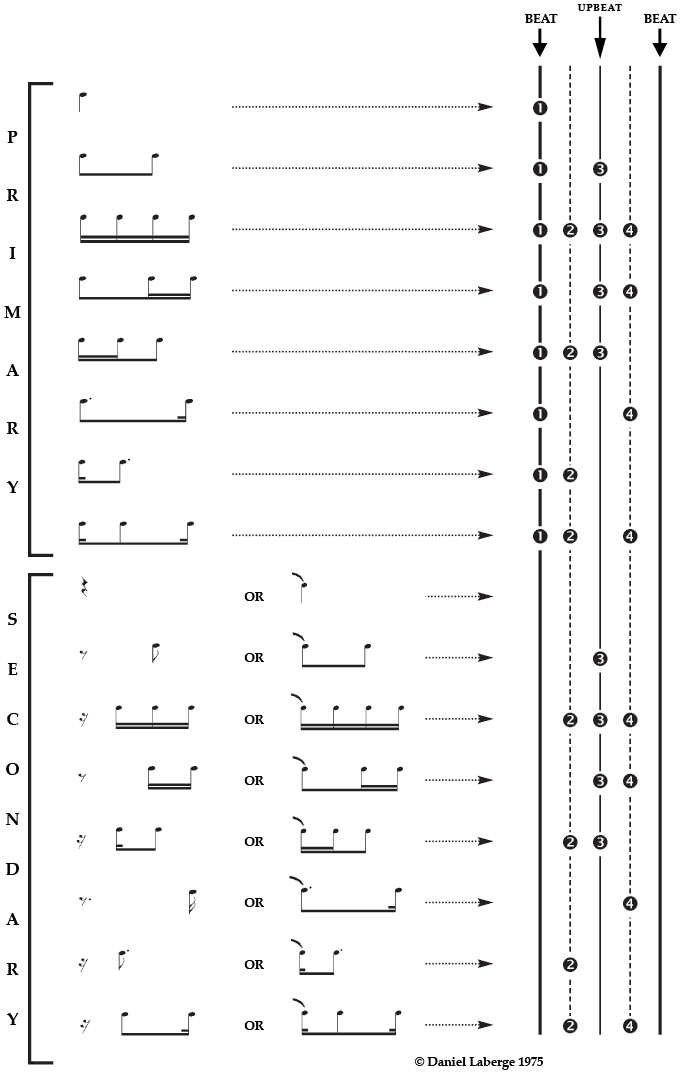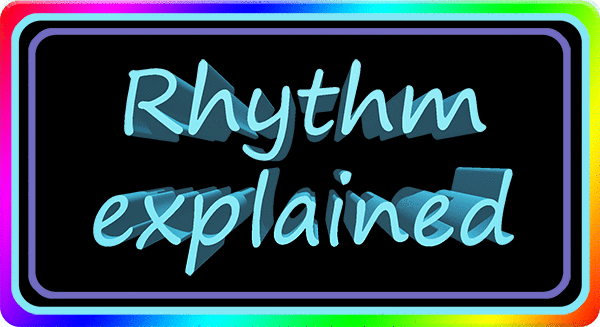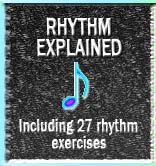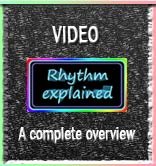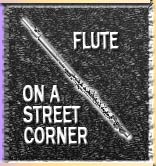ON THIS PAGE
RHYTHM THEORY
● |
The beats |
●● |
The binary beat division |
●●● |
The ternary beat division |
●●●● |
The division by four |
26 RHYTHM EXERCISES
● |
Beat exercises |
●● |
Binary exercises |
●●● |
Ternary exercises |
●●●● |
Division by four exercises |
All binary exercises have a swing version
Hi rhythm lovers,
The fastest way to understand rhythm is to watch the "Rhythm explained" video.
It covers all major aspects of rhythm, from beats to polyrhythms, and their evolution.
This video explains that there is a limited number of rhythmic possibilities:
• If the beat is divided by two; there are four rhythmic possibilities.
• If the beat is divided by three; there are eight rhythmic possibilities.
• If the beat is divided by four; there are sixteen rhythmic possibilities.
On this page, you'll find an exercise specifically dedicated to each rhythmic possibility.
Each exercise is preceded by a lesson, with graphic representations and detailed theory.
To help you learn, each exercise can be played back entirely on your loudspeakers or earphones at three increasing speeds.
For jazz musicians, the binary exercises also have a swing or double-swing performance.
Go to the bottom of the page for a link to the swing version.
The beats
Beats are the backbone of rhythm.
No beats, no musical rhythm.
Their origin is probably related to the beating of the heart, but mostly to the human walking motion.
Beats are regular pulses that every musician feels, but not necessarily the listener.
What is a beat?

The pulses must be felt, but they can also be expressed:
• Acoustically with the foot, the hands, a metronome or an instrument,
• Visually by a conductor.
Tempo.
How fast are the beats?
The speed of the pulses is called the «tempo».
The slowest beats are around two seconds long, while the fastest are shorter than a quarter of a second.
Tempo is calculated in beats per minute (bpm).
A tempo of 60 bpm means that there are 60 beats in one minute, so every beat lasts one second.
At 120 bpm, there are twice more beats per minute, so each beat lasts half a second.
The average tempo for all music is just above 100 bpm.
The tempo can vary during a piece of music and it often slows down at the end, but it generally remains stable.
The binary beat division
The binary family is large as it includes:
•Division by two
•Division by four
•Part of division by six
•Division by eight
This section is concerned with the simple division by two.
Any binary beat has two alternating parts: the downbeat and the upbeat.
Binary beats
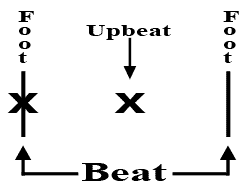
As you can see, there are only two places in a simple binary beat where events or notes can be positioned or played:
•The downbeat
•The upbeat
How rhythmic possibilities work
In simple binary music, for any given beat, you can only have one of the four following possibilities:
1• Only one event on the downbeat.
2• Events on both the downbeat and the upbeat.
3• No event at all.
4• Only one event on the upbeat.
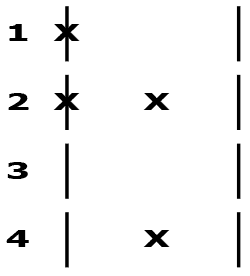
The binary master rhythmic figure
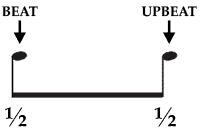
The rhythmic figure used to represent a binary beat is called:
TWO EIGHTH NOTES
Simple binary rhythmic possibilities
•2 Primary
•2 Secondary
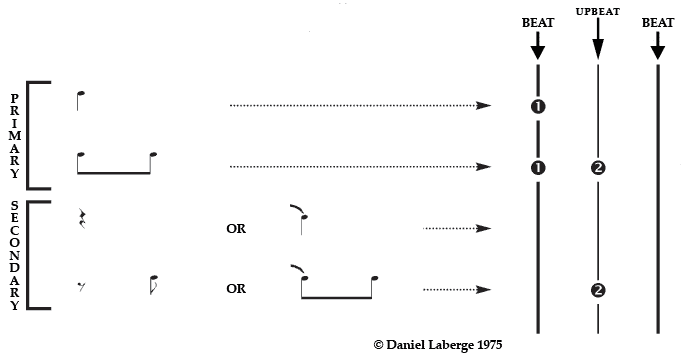
Primary and secondary rhythmic possibilities
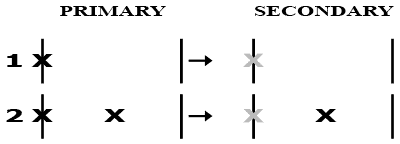
Secondary rhythmic possibilities lack the event that falls on the beat.
There is one secondary possibility for each primary one.
Because the beat is so important, secondary possibilities have appeared in history only after the primary ones had been well established.
The absence of an event falling on the beat can be due to:
•a silence, or
•a sound that is held over from the preceding beat.
Because of this, there are two ways to notate secondary possibilities:
•With a rest
•With a tie
The ternary beat division
The ternary family is small as it includes:
•Division by three
•Part of division by six
•Division by nine
Everything goes in thirds in ternary music.
A ternary beat has one downbeat and two upbeats.
Ternary beats
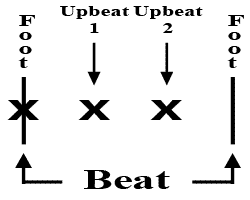
As you can see, there are three places in a ternary beat where events or notes can be positioned or played:
•The downbeat
•The upbeat 1
•The upbeat 2
The ternary master rhythmic figure
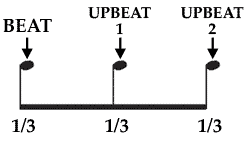
The rhythmic figure used to represent a ternary beat is called:
THREE EIGHTH NOTES
Writing ternary rhythm
In ternary music writing, each eighth note is worth one third of a beat.
Since two eighth notes always equal one quarter note; these now equal two thirds of a beat.
It takes a dotted quarter note to represent one beat.

Ternary rhythmic possibilities
•4 Primary
•4 Secondary
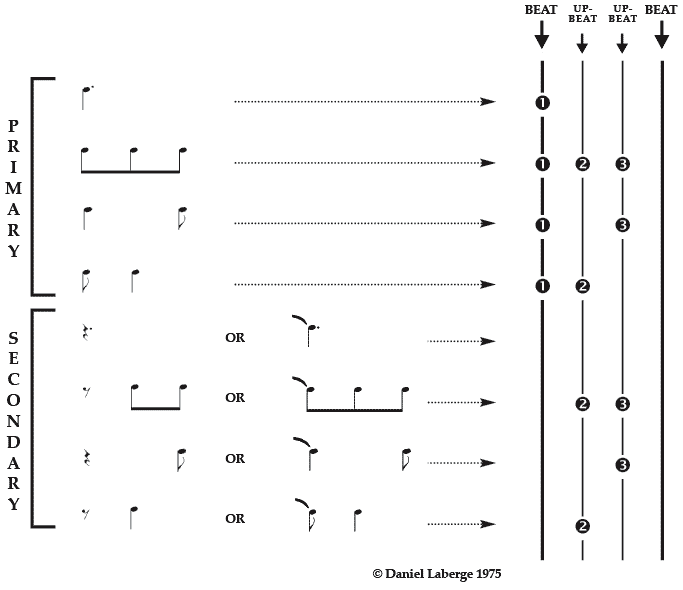
The division by four
Beats divided by four are part of the binary family.
This is the most common feel nowadays.
Everything goes in quarters in this type of rhythm.
Beats divided by four
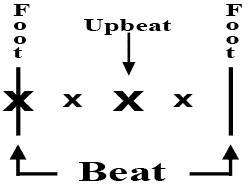
There are four places in a beat divided by four where events or notes can be positioned or played:
• The downbeat
• Between the beat and the upbeat
• The upbeat
• Between the upbeat and the following beat
The "division by four" master rhythmic figure
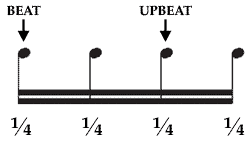
The rhythmic figure used to represent a beat divided by four is called:
FOUR SIXTEENTH NOTES
Binary rhythmic possibilities
•8 Primary
•8 Secondary
